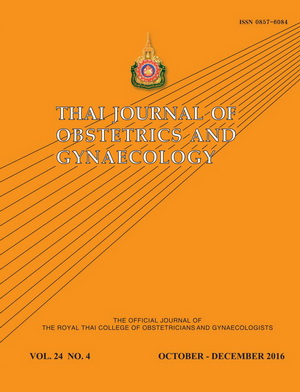Efficacy of Nakornping Uterine Compression Suture on Persistent Uterine Atony after Caesarean Section
Main Article Content
Abstract
Objective: The purpose of the study is to demonstrate the technique of applying Nakornping uterine compression suture after caesarean section and to evaluate the effectiveness of this surgical intervention for the management of uterine atony resistant to traditional medical treatments.
Materials and Methods: The medical records of 3,949 patients who had caesarean deliveries at Nakornping Hospital from October 2011 to September 2014 were retrospectively analyzed. Uterine atony occurred in 137 caesarean delivering patients. Sixty one patients with persistent uterine atony after receiving bimanual compression, uterine massage and uterotonic medications as per the hospital standard treatment protocol for postpartum hemorrhage management were treated with the placement of the Nakornping uterine compression suture. The mean time to perform the procedure was 2.2 ± 0.4 minutes.
Results: For all sixty one patients receiving Nakornping uterine compression suture, the treatment was successful. Nakornping uterine compression suture was sufficient to stop the bleeding immediately in 100% of the patients. There were no complications observed either during or after the procedure. All sixty one patients had normal lochia post caesarean delivery. The patients were discharged after a median of 4 days hospital stay. When pelvic ultrasound was done on day 3 and day 7 post operations on two patients, the study showed normal uterine contour and no fluid was found in the uterine cavity. Hysterosalpingography was performed on two patients on week 6 after the procedure, the study revealed normal findings. Four patients (6.6%) had subsequent pregnancies with caesarean delivery.
Conclusion: Application of Nakornping uterine compression suture was effective in treating uterine atony after caesarean section. It is a simple and rapid procedure in the clinical practice.


